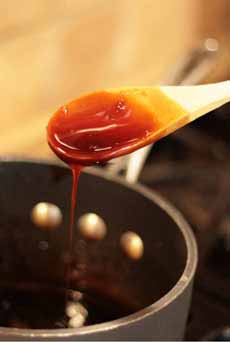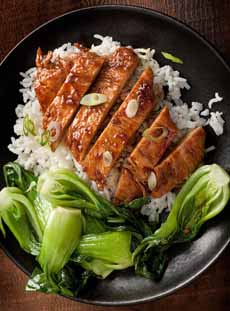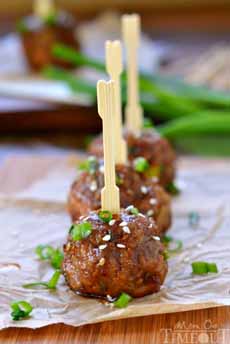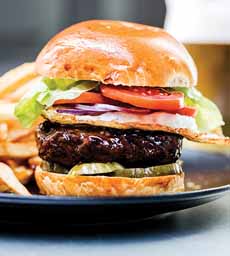TIP OF THE DAY: Teriyaki, Beyond Japanese Food
|
Teriyaki is a Japanese cooking technique in which foods are broiled or grilled with a glaze of mirin*, saké, soy sauce, and sugar†. Proportions vary according to the recipe: You can create a more sweet or more savory sauce, a thicker or a thinner sauce. Here‘s a basic teriyaki sauce recipe. The alcohol in the glaze gives a luster (teri) to the grilled (yaki) protein; the brown color comes from the caramelization of the sugar. Proper preparation of teriyaki involves repeated applications of the sauce during the latter stage of cooking until the sauce thickens and acquires luster (the meat or fish can also be marinated in the teriyaki sauce up to 24 hours before cooking). While some Americans grill the meat and then pour on the sauce, this does not produce the same results. The addition of garlic, ginger, sesame seeds, and/or chiles to teriyaki may be tasty but is not traditional. The bottled teriyaki sauces that contain them are actually versions of the spicier Korean bulgogi sauce, which features garlic and hot chiles. Teriyaki dishes are served with steamed white rice, which is made flavorful with the excess sauce. The dish is often garnished with chopped scallions (green onion). While chicken teriyaki seems to be the most popular in the U.S., it isn’t even on menus in Japan. Instead, the authentic teriyaki protein of choice is fish, such as mackerel, marlin, skipjack tuna, salmon, trout, yellowtail, and sometimes, squid. > The history of teriyaki is below. > A recipe for build-your-own teriyaki bowls is also below. > So is a recipe for that delicious Japanese carrot-ginger dressing. ________________ *Mirin and saké are types of rice wine. Both are fermented from rice, but mirin has a lower alcohol content and higher sugar content (as an analogy, thing of sweet and dry vermouths). If you have saké but no mirin, make a mirin substitute by adding a half teaspoon of sugar to the saké, and warm it slowly to dissolve the sugar. †Modern American substitutes include honey for the sugar and other alcohol for the saké (e.g. bourbon, vodka). Most of the modern Japanese dishes familiar in the U.S. first appeared during Japan’s Edo period (1603 to 1867), an era characterized by stability and economic growth. That included exposure to new ingredients from abroad, which gave rise to new styles of cooking. Food historians believe that teriyaki was created in the 17th century, one of a number of new dishes using roasted or grilled fish and meat. The special sweet-and-savory glaze distinguished teriyaki from other grilled dishes. With the proliferation of Japanese restaurants in 1960s America (thanks to the 1965 Immigration & Nationality Act, which enabled many more Asians to emmigrate), teriyaki dishes became popular [source]. To cater to American tastes, beef, chicken, lamb, pork, salmon, and tofu with vegetables were offered instead of the traditional varieties of fish. More recently in the U.S., fusion cooking has engendered teriyaki burgers, meatballs, and other variations; and teriyaki sauce is used as a dipping sauce and a marinade ingredient (more about this in a minute). |
 [1] Homemade teriyaki sauce (photo © Olive This).
|
|
|
In fact, the concept of a discrete teriyaki sauce (as opposed to a glazed fish dish cooked teriyaki [grilled] style) is believed to have originated in Hawaii, among Japanese immigrants. Local pineapple juice was incorporated, not just for flavor: Its enzymes also help to tenderize the meat. According to a history on Leaf TV, “there is apparently no official teriyaki sauce history, and the term refers rather to the aforementioned cooking method, and applies primarily to the preparation of fish, such as mackerel, salmon, trout and tuna.” Teriyaki was part of the first wave of Asian flavors to find a foothold here (source). Modern trends find teriyaki in all sorts of comfort food, from burgers and meatballs (try a meatball bánh mì sandwich) to grain bowls. Flavor And The Menu, a magazine that shares national restaurant trends for chefs and restaurateurs, notes dishes like these popping up nationwide: |
||
|
|
RECIPE 1: BUILD YOUR OWN TERIYAKI BOWL Mix and match: |
|
|
RECIPE#2: JAPANESE CARROT-GINGER DRESSING Love that textured, orange salad dressing at Japanese restaurants? It’s easy to make at home: Ingredients 1. PLACE all ingredients except the oil in a blender. Process until liquified. 2. ADD the peanut oil and pulse a few times to combine. CHECK OUT WHAT’S HAPPENING ON OUR HOME PAGE, THENIBBLE.COM. |
||






